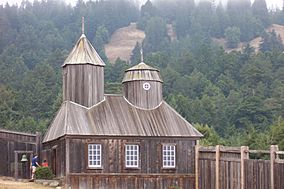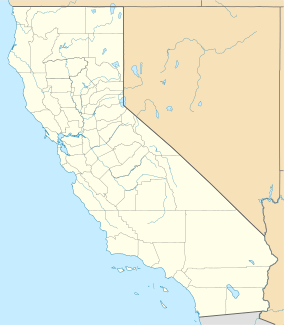Fort Ross State Historic Park facts for kids
Quick facts for kids Fort Ross State Historic Park |
|
|---|---|

The reconstructed chapel of Fort Ross
|
|
| Location | Sonoma County, California, USA |
| Nearest city | Jenner, California |
| Area | 3,393 acres (1,373 ha) |
| Established | 1909 |
| Governing body | California Department of Parks and Recreation |
Fort Ross State Historic Park is a historical state park in Sonoma County, California, including the former Russian fur trading outpost of Fort Ross plus the adjacent coastline and native coast redwood forests extending inland. Fort Ross, active from 1812 to 1842, was the southernmost settlement in the Russian colonization of the Americas. The 3,393-acre (1,373 ha) park was established in 1909. The site is a Sonoma County Historic Landmark.
Fort Ross
Fort Ross was founded by the Russian-American Company in 1812. Most of the Fort's buildings are reproductions. The one original structure remaining from the Russian settlement, the commander's house, is a National Historic Landmark and on the National Register of Historic Places. The California Department of Parks and Recreation as well as many volunteers put extensive efforts into restoration and reconstruction work in the Fort.
Name
The name Ross is a poetic name for 'Russian.' It was selected from lots placed at the base of an image of Christ bestowed on the settlement when it was dedicated on September 11, 1812. The Spanish sometimes called it Presidio Ruso or Presidio de Bodega.
Park access and closures
In 2009 the park was under the risk of being closed due to state budget cuts. Russian ambassador Sergey Kislyak petitioned in favor of the park, but Governor Arnold Schwarzenegger promised nothing. On June 22, 2010, a memorandum of understanding between the Renova Group of Companies and the State of California, and between Renova Group and Fort Ross Conservancy (then the Fort Ross Interpretive Association) was signed in San Francisco in the presence of Russian President Dmitry Medvedev "to affirm a partnership to support and promote the preservation of California's Fort Ross State Historic Park, and to raise awareness of its historical and cultural significance." The threatened park closures were ultimately avoided by cutting hours and maintenance system-wide.



